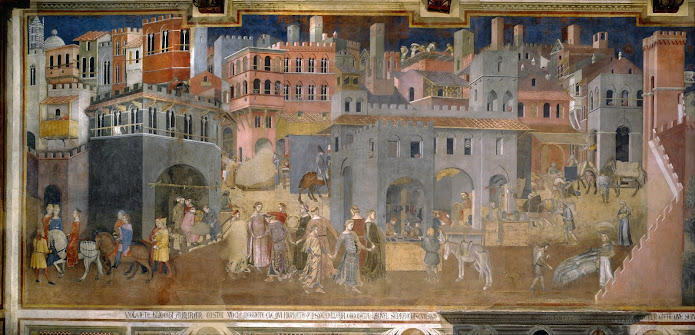In this Blog post, I will be looking at three different works, from three different artists that we read about in the Classical unit. The artists are Jacques-Louis David, Angelica Kauffman, and Benjamin West. While there was a lot of art being created at this time that was quite diverse, I saw, what I interpreted as a deeper level of morality in the following works. All three of the works I chose have tones of death, morality, grief, and sorrow. I will now go over each piece, and explain its relation to morality and the tones previously mentioned.
 |
The Death of General Wolfe
|
The first piece I will be looking at is by the American painter, Benjamin West. This piece, titled
The Death of General Wolfe was painted in 1770, and is an oil on canvas style and is on display at The National Gallery of Canada, in Ottowa. This painting is a depiction of how this General Wolfe, died in battle during the Seven Year War. Now, how dose this piece relate to morality? When you look at the very definition of what morality is, "Principles concerning the distinction between right and wrong or good and bad behavior."(1), we can see how amidst a brutal battlefield full of death, there is respect and good morals displayed by the opposition. Instead of taking the loss of the general as a window for attack, you can see a humanistic and moral tone, where the loss of the leader almost freezes what's going on. The death of a figure of leadership for these people transcended the momentary conflicts, yet another aspect of what makes this piece highlight morality.
 |
The Death of Socrates
|
The next painting we'll be looking at, is from another artist covered in class, Jacques Luis David. This piece was painted in 1787, and is also oil on canvas and is on display at the MOMA in New York. This relates to the first painting not only with death as a major part of if, but the morality found within this, even on a surface level, is palpable. A bit of context about this work, is that Socrates was said to have been "Accused of corrupting the youth of the city and denying the gods."(2) He was given the noise to recant or to drink poison, and he chose the ladder. His body language is thought to be foreshadowing his fate by pointing towards, where the body language of his followers show various stages of grieving. This is once again showing the effects that death has on ones followers and that the emotions brought fourth by that transcend hate or anger. Instead of unleashing their frustration on the Athenian Government, who brought this upon Socrates, they stoped what they were doing and mourned the loss. A factor that makes this such a good example of morality, is that Socrates chose to die, rather than renounce his beliefs, in a way he held the moral high ground and won the battle.
 |
The Sorrow of Telemachus
|
The third and final piece we will be looking at today, is know as
The Sorrow of Telemachus, by Angelica Kauffmann. Made in 1783, this is another oil on canvas painting, on display at the MOMA in New York and the story this tells, while simple, is fascinating. Telemachus is a character form a French novel known as "The Adventures of Telemachus", where Telemachus is the son of Odysseus. This painting shows Telemachus on Calypso's island, where her nymphs are singing a song about Odysseus. This is bringing sorrow to Telemachus, as he misses his father, so Calypso tells them to stop singing. Even though this painting doesn't directly have death as a main subject, it is clearly the source of Telemachus' sorrow, making it a main subject that one, may not see during their first impressions. This is a clear depiction of morality as Calypso is recognizing the pain brought to Telemachus, and is attempting to relive it. In works with morality as a strong tone, body language is one of the main aspects, so to see Telemachus in the position he is in, without any previous knowledge of the subject, you can tell that he is sorrowful and that the female character is attempting to help, by taking the morally 'right' decision.
References
*I was trying something new with the format of this blog, using the images to separate it into thirds. to go for a more simplistic look. I will review this once posted and see if I prefer this or the more standard format that my last posts have. If there is any trouble with viewing this, let me know!






I really like the paintings you chose. I see where you mean that the death of the General cause almost like a pause in the battlefield to give chance for acceptance of result. It also seems to me like the soldier on the left side is running with what looks like a white flag; maybe? You can also see the shook in the other soldiers almost in disbelief that this happened, enhancing at the emotion of the painting.
ReplyDeleteThe death of Socrates seems as if Socrates is telling his followers not to worry, and that everything will be fine, ensuring them that this is not the end.
On the Sorrow of Telemachus you can feel the sorrow with the kind of lighting that the painter chose to interpret, you can clearly see that they are trying hard to cheer her up.